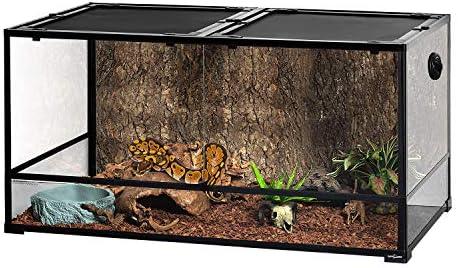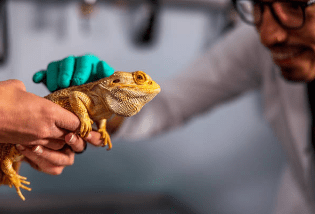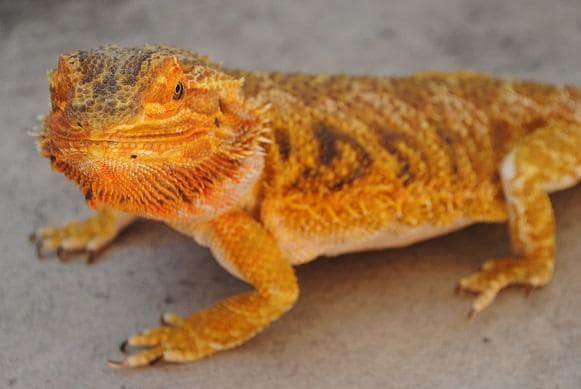Ah, bearded dragons, the adorable, spiky friends that have stolen our hearts.
As a seasoned reptile aficionado, I get why you’re head over heels for these critters. But hey, love comes with responsibilities, like keeping an eye on their teeny-tiny noses.
Sure, their noses might seem insignificant, but they play a crucial role in a dragon’s well-being.
Just like you wouldn’t want a stuffy nose all day, bearded dragons prefer their nasal passages clear.
That brings us to the oh-so-mysterious subject of bearded dragon nose plugs.
Intrigued yet? Stick around.
This article offers an in-depth look into why do bearded dragons have nose plugs, the impact on their health, and preventive measures.
So sit tight; your dragon’s respiratory health is about to level up.
Table of Contents
What are Bearded Dragon Nose Plugs?
You’ve probably heard the term “bearded dragon nose plugs” and wondered, “What in the reptile kingdom is that?” Don’t worry; you’re not alone. Let’s demystify this enigmatic term, one bullet point at a time.
- What They Are: Bearded dragon nose plugs are essentially hardened mucus or skin that blocks the nostrils. They’re like a tiny, uncomfortable cork for your dragon’s nose.
- How They Form: These plugs can form for a variety of reasons, from dehydration to poor enclosure conditions. It’s not just one culprit but a host of factors that could contribute.
- Appearance: You’ll recognize them as small, crusty substances near or in the nostrils. It’s like your dragon decided to try out a new, but highly inconvenient, accessory.
- Visibility: Usually visible to the naked eye, nose plugs are not some mysterious hidden condition. If you’re attentive to your dragon, spotting them should be straightforward.
- Potential Harm: While they may seem harmless, reptile’s nose plugs can lead to a range of issues, from breathing difficulties to increased risk of infections. They’re small but mighty in impact.
Why Do Bearded Dragons Have Nose Plugs: Common Factors
Alright, so you’ve noticed the plugs. Don’t panic. Multiple factors contribute to these unusual additions to your bearded dragon’s nose. Let’s dive into the nitty-gritty.
Inadequate Shedding
First up, inadequate shedding. Your bearded dragon has skin that needs to regenerate. Sometimes the old skin doesn’t fully come off, especially around intricate areas like the nose. This leftover skin can dry up and form plugs. Think of it as a reptilian beauty routine gone awry.
Incorrect Tank Humidity
Rolling into the second point, humidity plays a key role. If you get the tank conditions wrong, nose plugs can form. Too dry, the skin and mucus harden; too moist, bacteria thrive. The tank’s environment is a crucial piece in the bearded dragon nose plug puzzle.
Dehydration
Dry dragon equals dry mucus. When your bearded dragon is not sufficiently hydrated, the mucus in its nose can become thick and sticky. This eventually hardens, forming those pesky nose plugs. So, don’t skimp on that H2O.
Lack of Rubbing Objects
Let’s turn our attention to rubbing objects. Just like you use a washcloth, your bearded dragon needs objects to help remove dead skin. When those are missing, your dragon can’t “scrub” effectively. The result? More nose plugs. So, consider these objects their spa essentials.
Poor Enclosure Conditions
An unclean enclosure is basically a breeding ground for bacteria and germs. When these accumulate around the nostrils, they can solidify into nose plugs. It’s like refusing to take out the garbage and then wondering why the house smells. Your dragon deserves better.
Respiratory Infections
Last but not least, if your bearded dragon is suffering from a respiratory infection, nose plugs can be a symptom. It’s akin to us getting a stuffy nose when we’re under the weather. In this case, a vet visit is non-negotiable.
Effects of Nose Plugs on Bearded Dragons
Alright, we’ve established what bearded dragon nose plugs are and why they form. Now, let’s dive into the nitty-gritty—what happens when your pet dragon has a nose plug? Spoiler alert: it’s not a walk in the park.
Respiratory Difficulties
First on the docket is respiratory issues. A plugged nostril is, quite frankly, a blocked airway. This can make it hard for your bearded dragon to breathe and lead to respiratory distress if not addressed. They may start mouth-breathing, which isn’t the norm for these critters and indicates a problem.
Increased Risk of Infections
One nose plug might invite others to the party. If the initial plug is due to bacteria or fungi, the chances are that more will follow. A moist, plugged-up nose is a haven for microorganisms, and before you know it, we’re looking at a full-blown respiratory infection.
Impaired Sense of Smell
Bearded dragons rely on their sense of smell for various activities—like hunting and navigating their environment. A nose plug can dampen this sense, making it challenging for your pet to engage with their world as they usually would. This is a bigger deal than you might think.
Reduced Appetite
Ever try eating when you can’t breathe through your nose? Not fun. Your bearded dragon feels the same. With a nose plug, their appetite can dwindle, impacting their nutritional intake. This can be particularly worrying for younger dragons that are still growing.
Stress and Discomfort
Nobody likes feeling out of sorts, not even bearded dragons. A nose plug can cause them noticeable discomfort. You may see your dragon scratching at their nose or even trying to rub it against objects in their enclosure to relieve the irritation. If that doesn’t scream “I’m uncomfortable,” I don’t know what does.
Poor Quality of Life
When you sum it up, a bearded dragon nose plug can put a serious damper on your pet’s quality of life. They may become less active, show signs of stress, or even develop behavioral changes. It’s not just about the nose; it’s about their overall well-being.
Preventing and Treating Nose Plugs
Alright, we’ve gone through the gloom and doom of what reptile nose plugs can do to your bearded dragon. But fear not! We also have some surefire tips to help you prevent and treat these pesky problems.
Ready to give your dragon a breath of fresh air?
Preventing Measures
Before we get into drastic measures, let’s focus on prevention. An ounce of prevention is worth a pound of cure, especially when it comes to bearded dragon nose plugs. So what can you do to avoid nose plugs from forming in the first place?
Maintain Proper Tank Humidity
Contrary to a tropical lizard, your bearded dragon doesn’t bask in high humidity. Keeping your tank’s humidity levels at a recommended 35-40% is crucial. Too humid and bacteria proliferate; too dry, and the shedding process may cause nose plugs. Get a reliable hygrometer to keep tabs on humidity levels.
Hydration
Water matters, folks! It’s simple: A well-hydrated bearded dragon is less prone to nose plugs. Regular baths and misting can help keep your dragon moist enough to prevent those dreaded plugs from forming. However, avoid overdoing it, as too much moisture can also create problems.
Rubbing Objects
Sometimes, a dragon just needs to rub one out—a nose plug, that is. Rough surfaces or objects in their enclosure provide the opportunity for self-help. These could be branches, rocks, or even a piece of untreated hardwood. These ‘rubbing objects’ can aid your dragon in dislodging minor plugs on their own.
Proper Enclosure Conditions
A clean, well-ventilated enclosure is like a palace for your bearded dragon. Poor enclosure conditions can be a breeding ground for bacteria and fungi, which, as you’ve guessed, are the bad guys here. Ensure the tank has good airflow and the temperature is within the optimal range for bearded dragons.

Regular Cleaning and Maintenance
Last but certainly not least, a clean home is a happy home. Regularly clean the enclosure, disinfect surfaces, and replace substrate to minimize the risk of nose plugs. Doing a thorough cleaning at least once a week can make a world of difference.
Treatment Approaches
But what if you’re already dealing with reptile nose plugs? No worries, we have a game plan for that too. Let’s break down the steps for effective treatment.
Gently Remove Nose Plugs
Step one: The DIY approach. Make sure your hands are clean and, with utmost care, you can try to gently remove the nose plug using tweezers. Just be cautious, as excessive force could harm your pet. If the plug doesn’t budge easily, stop there and consider the next step.
Consult a Reptile Veterinarian
Sometimes the plug is just too stubborn or the issue recurs. When in doubt, take your bearded dragon to a specialized reptile veterinarian. They have the expertise to properly diagnose and treat your scaly buddy, ensuring no harm comes to them.

Medication
In some cases, medication may be needed. If a bacterial infection is found to be the root cause of the nose plug, your vet may prescribe antibiotics. Topical ointments may also be suggested for easier removal. It’s crucial to follow the dosage and application instructions to a tee.
Conclusion
Taking care of your bearded dragon‘s nose health is not a nosy endeavor—it’s essential. With the info in this article, you’re now equipped to prevent and treat bearded dragon nose plugs. Trust me, your scaly friend will breathe easier, and so will you.
FAQs
Can bearded dragon nose plugs lead to serious health problems?
Yes, untreated nose plugs can result in respiratory difficulties, increased risk of infections, and overall poor quality of life for your bearded dragon.
How can I recognize if my bearded dragon has nose plugs?
Bearded dragon nose plugs typically appear as small, crusty substances near or in the nostrils and are usually visible to the naked eye.
Is it safe to remove the nose plugs myself?
While some owners successfully remove minor nose plugs gently, it’s best to consult a reptile veterinarian for severe or recurring cases.
Alina Hartley is a small-town girl with a ginormous love of bearded dragons. It all started with Winchester, a baby bearded who was abandoned at the shelter by his former owners because of a birth defect that caused one front leg to be shorter than the other. Alina originally went to the shelter looking for a guinea pig, but one look at Winchester and it was love at first sight. From that day on, Alina has dedicated her life to learning everything she can about bearded dragons. She loves helping new beardie parents start their incredible journey with these magnificent reptiles.
Follow her on:
LINKEDIN
TWITTER.
Read her latest articles HERE
Learn more about her HERE.

